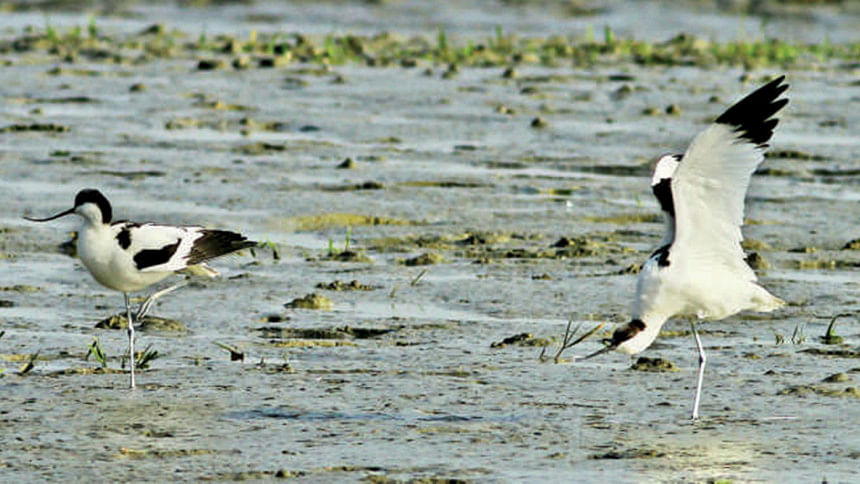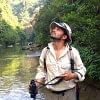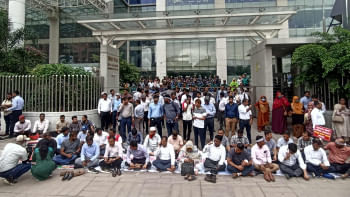Memoirs of the wave island


Dhaka was surprisingly fogless as I headed southward towards the sea at dawn that late December. It was the last mode of transport for the day to get to Hatia Island when I reached the 'ghat'. The destination, Domar Char, the wave island, one of two detached limbs of Hatia Island, the other being Nijhum Dwip, the silent island.
We took a rickety wooden trawler, which had a small engine cabin at the back and a plank at the front with an elongated centre where all the passengers congregated, mostly standing, except one 'Shaheb' who got himself a chair. The boat headed further south taking advantage of the ebbing tide.
The Brown-headed Gulls flew around our boat, some silhouetted against the sun in the background - a shining bright orange plump disk. Slowly the moon appeared to the east and the sun disappeared leaving an enlarged saucer-shaped reddish tint to the west.
As the moon brightened, the cones of numerous waves over the murky water surface sparkled synchronously. Our boat floated with the current keeping alongside a muddy creased and folded bank. The tide fed on those banks made by sand, silt and soil, which formed the illusion of a line of uneven dumpy stairs. The eave-like top of the bank was densely covered with grass, and against the tidal force it often broke down, dispersing chunks of green at each step.
When we landed on Domar Char, it looked different from the last memory I had of it. The sand dunes facing the sea were further stretched and the creek that separates the sand and the 'Uri Ghash' had enlarged due the harsh game of tide.
We walked through the silver-white sand, premeditated by the air and the water. The spring tide receded quickly, leaving an imprint of long dark lines created along the edge of the water by twigs, dry grasses and rotten foliage. The sand had wrinkles all over, some broad; some narrow, and appeared as if the muddy water surface suddenly froze when the waves went wild. As the sand met the mud and the bay, it transformed to solid brown. And then when the tidal water broke on its chest and with the sun shining on its surface, the silicon shimmered like tiny diamond dots.
A River Tern pair hovered around us, sometimes diving into the air and stopping just above our heads - a great deal of effort to protect their turf. A flock of shorebirds flew with bursting-speed as we walked further, in white and brown flashes against the green 'Uri Ghash' field and mature 'Kewra' patch at the distance.
The feral water buffalo herd looked at us with curious yet bored eyes; the large males had enormous and lethal horns capable of killing people. Although the likelihood of being chased by them is generally slim, they can cause real panic!
Many of these islands have stepped into secondary succession, and offer gigantic salt marshes encircled by mudflats and centred by planted mangroves. Regardless of the remoteness of these remarkable islands, most of these 'chars' or islands are now becoming thinly inhabited by people and the materialistic, greedy hands of 'Shahebs' and 'Mias' from the mainland are extending over these mud lands to consume whatever they can. As these are so remote, they found a unique way to exploit and meet their greed; this time they had released their cattle to feast on the grasses and mangroves that the mud-lands provide with such austerity.
The Black-tailed Godwits rapidly foraged on the evolving mud before it is submerged under the approaching high tide. The Curlews hunted on small crabs hidden under the muddy grasses with their elongated down-curved bills. Of all the shorebirds that we saw, one has always fascinated me with their brilliant up-turned bill shape, unblemished black and white outfit and long and graceful grey legs; the Pied Avocets. We saw a few of these feeding on worms twisting their bills sidewise. We counted all we saw and took photographs. We ended the day with the sighting of a group of Bar-headed Geese flying to the east, echoing their mesmerising 'aang aang' calls. After a few more days of sun and sand, we headed back to the unpleasant city cherishing new and old memories attached to the wave island.

 For all latest news, follow The Daily Star's Google News channel.
For all latest news, follow The Daily Star's Google News channel. 



Comments